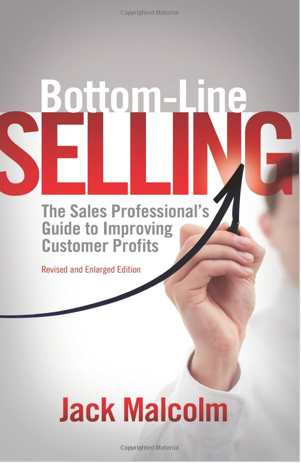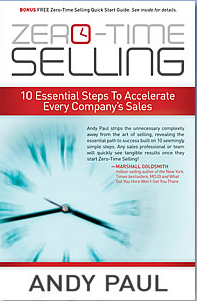What I’m Reading: Two New Books on Sales
 I’m reading a lot lately. Some of it’s more out-there, some of it’s rock-solid business. Two books that fall into the latter category are Jack Malcolm’s Bottom-Line Selling, and Andy Paul’s Zero-Time Selling. Both are good – what’s important is why.
I’m reading a lot lately. Some of it’s more out-there, some of it’s rock-solid business. Two books that fall into the latter category are Jack Malcolm’s Bottom-Line Selling, and Andy Paul’s Zero-Time Selling. Both are good – what’s important is why.
Bottom-Line Selling
Do you pay attention to the blurbs on the back of the book? Many people don’t, but I do. I think who is talking about you says a lot about who you are. It’s why I’m so terribly proud of the names on our own just-published book.
David Brock wrote the forward to Bottom-Line Selling, so I immediately took it seriously. And rightly so.
I expected a book with a few good insights, but this book fits another category: the all-you-need-to-know about a topic category. And the topic is understanding your customer’s business.
That is a huge topic. In theory it’s endless; you can never know all there is to know about your customer. In practice, most salespeople give up way too soon. So an all-you-need-to-know book must balance boiling the ocean with accepting appearances only. Malcolm does this admirably.
This is a high-content book. It’s a bit of a mini-MBA course. It begins by defining value in financial and customer terms, and telling you very precisely where to look to find it. It goes on to address key concepts like efficiency and effectiveness, again using broad but very sharp definitions. It ends by giving practical, high level advice on how to sell value, and who to talk to.
More could be, and has, been written about all this. But if you want a single reference book to help define your entire approach to selling, I think this one is a strong candidate. Thumbs up.
 Zero-Time Selling
Zero-Time Selling
Andy Paul, in Zero-Time Selling, has written a different book – one that takes a concept and drives it across the entire field of sales. The concept is responsiveness – a subject that is increasing in relevance, and has applications across the entire chain of sales activities.
Andy introduces us to MILT – an avatar, but more importantly, an acronym. It stands for Maximum Impact in the Least Time possible. MILT is about responsiveness – which is not just about speed, but about relevant content. The race goes, increasingly, to those who can be maximally responsive.
This makes sense to me. Let’s say you find two providers on the web:
- Provider 1. Site looks great, but thin on information. You decide to call, not email, because you’re in a hurry. You leave a message, get an automated mail, a first response the next day, and in 2-3 days you end up with a semi-customized proposal.
- Provider 2. Site is loaded with relevant information, leading to a critical question for you. You click on “talk now,” and are connected with an intelligent person. You get an answer to your critical question, and that raises an issue you hadn’t thought of. You get directed to a relevant online page, and talk to another person. By the end of the call – 45 minutes – you are clear enough to make a decision. And you probably do.
Those are my examples, not Paul’s. In fact, he goes way beyond my simplistic cases and offers aggressive concepts and mindsets, and Ten Simple Solutions to make it work.
He’s not kidding. Paul says things like, “Fast means now; everything else is slow.” Want an anology? Think last year’s US football’s national collegiate championship, between Oregon and Auburn – both teams devotees of the no-huddle offense. Speed kills, as in, “Speed kills the competition.”
His Ten Simple Solutions cut a wide swath which include: Follow up 100% of Sales Leads, Do Everything Now, and Start Small. I don’t agree with every little thing he suggests but that’s quibbling.
Andy Paul makes a strong case for the power that comes from delivering the real deal fast. And, to his great credit, he suggests it is at least equal part mindset as well as process and skill-set. I can’t think of a business for which this rigorous thought exercise is not powerfully relevant.

Leave a Reply
Want to join the discussion?Feel free to contribute!